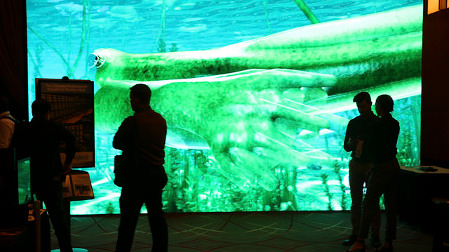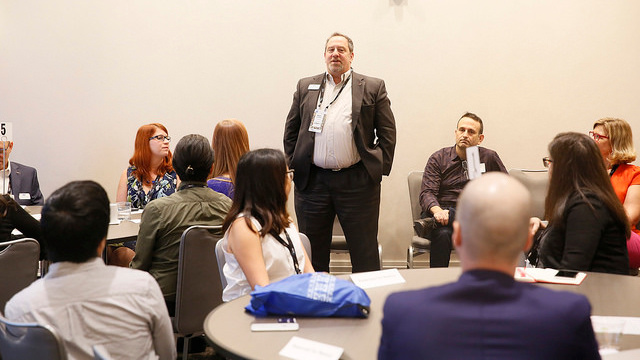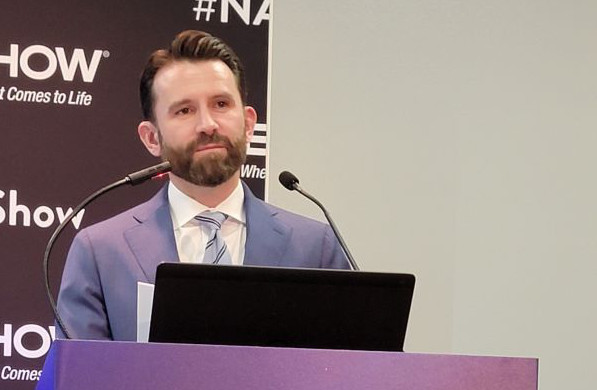At Record-Setting SMPTE, One Number Stands Above The Rest
HOLLYWOOD, CALIF.—A simple look at the numbers reveals the SMPTE 2017 Annual Technical Conference & Exhibition last week in Hollywood, Calif., was a success. More than 2,500 registered attendees (a record); 105 exhibitors, and 70 presentations on some of the most important technical issues facing the motion picture and television industry adds up to another high mark for the standards body.

More than 100 exhibitors showcased their latest technology at the SMPTE 2017.
However, there was a far more important number for the industry in general and SMPTE in particular being discussed at the event. That number is 30.
On the last day of the conference (Oct. 26), John Footen, a leader in Deloitte’s Technology Strategy and Architecture Practice for Technology, Media & Telecoms asked those attending his “The Future of Technology in the Future of Broadcasting” to stand up if they were younger than 30 years old. Of the estimated 200 people in attendance, two said they were younger than 30. One was a scientist, not an engineer, and the other declined to identify her role in the industry.
YEP PROGRAM
While certainly not a scientific survey, a casual observation of those attending other sessions—wandering the aisles from booth to booth in the two exhibit halls and participating in after-hour events like the SMPTE Oktoberfest and Spooktacular—indicates Footen’s poll wasn’t too far off the mark.
SMPTE has recognized the need to attract younger professionals for some time. On the creative side of the business, the organization—along with HPA, which consolidated with SMPTE two years ago—has attracted young filmmakers with the annual SMPTE-HPA Student Film Festival. Likewise, on the technical side—where SMPTE has made its bones for just over 100 years—the pair are tackling the dearth of young blood as well, according to Matthew Goldman, SMPTE president.

SMPTE President Matthew Goldman talks with attendees at SMPTE’s Young Entertainment Professional day-long conference.
“I just came from an all-day event here [at the Loews Hollywood Hotel] that is actually the HPA’s event—sponsored along with SMPTE—called the ‘Young Entertainment Professional,’ or the YEP, program,” said Goldman, who is also senior vice president of technology at Ericsson. YEP is a yearlong program for young engineers five to seven years into their careers, he said.
In Hollywood, the daylong YEP event was focused on mentorship for the “huge crowd” of YEP participants in attendance, Goldman added. “In broadcast in general, it’s the aging of the population. If you look at professional media as a whole, it’s not that way,” he said. “We are looking to strengthen our programs to be more relevant to people in the early part of their carriers, which is usually when you are in your 20s.”
VISION 2020
To that end, SMPTE is on a mission as part of its Vision2020 strategic plan to have 30 percent of its members under 30 years of age, according to Goldman. Back in Salon 2 at the Ray Dolby Ballroom where Footen was making his presentation, the conversation turned to changes in areas where television engineers and tech personnel work and what that may hold for the future. To illustrate the diminishing role for R&D engineers at broadcast organizations, Footen invited Bob Seidel, vice president of engineering and advanced technology at CBS and past president of SMPTE, to the microphone to talk for a few minutes about the CBS Technology Center in Stamford, Conn.
In its heyday, the lab, which closed in 1986, employed as many as 150 engineers tackling R&D projects in areas like videodisc, high definition television, color cameras, image processing and tape, he said. Today, there are five CBS R&D engineers, one of whom previously worked at the tech center.
While HPA has YEP and SMPTE its 30-under-30 goal, the industry at large must find a way to make television attractive to younger people, said Footen. “Our industry is not considered sexy anymore,” he said. “A TV station in the ‘60s or ‘70s was like a startup. It was the hot place to work. It was a place you wanted to go work.”
Footen sees the situation eventually working itself out with a large number of engineers retiring over the next several years and wages becoming more competitive with the IT industry. The approach to management must also change, he said. “I need to be able to walk into a TV station and see the ping-pong table and latte machine,” he said. “Make it sexy. Make it that the next generation will want to work in our field. Make it like it was before.”
Get the TV Tech Newsletter
The professional video industry's #1 source for news, trends and product and tech information. Sign up below.
Phil Kurz is a contributing editor to TV Tech. He has written about TV and video technology for more than 30 years and served as editor of three leading industry magazines. He earned a Bachelor of Journalism and a Master’s Degree in Journalism from the University of Missouri-Columbia School of Journalism.

